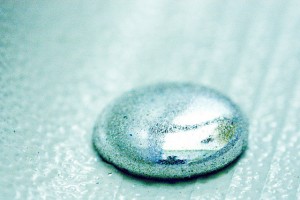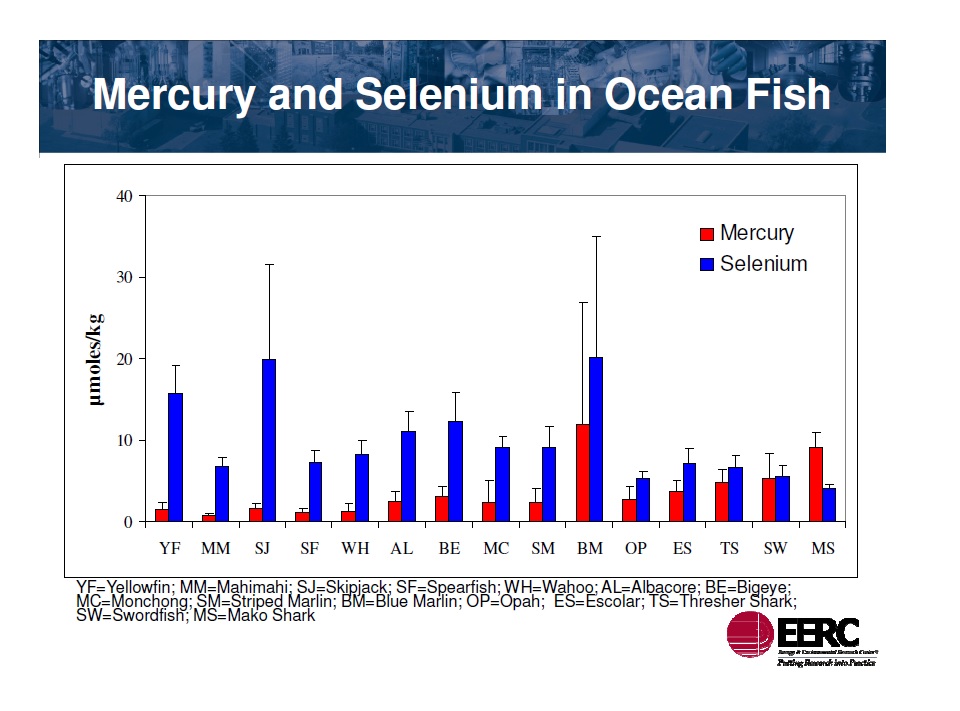Mercury in Tuna and Fish – How Worried Should You Be?

We’re having some friends over for dinner tonight, and my fiancee asked me earlier what we should cook.
My default reply to this question is whatever sounds most delicious and appetizing to me at that particular moment in time, so I quickly said, “beef stew.”
She stood there and glared at me for a minute or two, while I tried to figure out why my answer wasn’t the right one. (At the very least, I knew the glare meant that much.)
Apparently, our friends don’t eat red meat or shellfish, and apparently I had been told this a few hours earlier. Upon hearing it again, I looked at her dumbfounded and asked “Why Not?”.
“They think they’re being healthy.”
Ok. I understand. They’re sorta like the juice-fasting friends we have. I’m down with that. I’ve done much crazier things in my life than drinking juice or cutting out red meat. I would never do either of those things, but we can still be friends.
The funny thing is, I don’t judge my friends nearly as much as they think I do. I was the unhealthiest eater on earth for decades, so every bit of ground I ever had to stand on was washed away by the tsunamis of Cherry Coke and Mountain Dew that I drank.
However, I write, speak, and coach because I do like giving people information and tools that they can use to make better decisions if they want.
Today’s post is not about red meat – I talk about that elsewhere – but rather about mercury in tuna. I was reminded by this incident earlier today that I also have friends who won’t eat a bunch of seafood (or feed it to their kids) because they’re worried about mercury levels.
I kinda wonder if we’ll still be friends after they read my posts about them?
(As a preface, much credit for this article goes to Chris Kresser, who interviewed Dr. Nicholas Ralston (quoted in this post) and got me interested in the subject. You can find Dr. Nicholas Ralston here.)
Why Are Folks Worried about Mercury Poisoning?
We might as well start with why anyone is worried at all about mercury at all.
Here is a video in which I explain some of the concerns
I know that most people have heard from TV, magazines, and a variety of other places not to eat too much tuna or certain other fishes. Even Mark Sisson has warned us about mercury in tuna.
It turns out that there are a few particular instances around the world that have been studied to death and used as examples of the dangers of mercury poisoning:
- The most popular study is about the Faroe Islands, where kids had severe neurological damage due to mercury poisoning. (The Faroe Islands are a small group of island between Norway and Iceland).
- Another popular example is from a place called “Minamata Bay” in Japan, in the 1950s. In that case, there were millions of cases of severe neurological damage, and around 900 people ended up dying due to mercury poisoning.
- Finally, over 6,000 people were hospitalized in Iraq in the early 1970s due to mercury poisoning.
These are the biggest and scariest examples, and it’s clear that mercury poisoning is a real and dangerous threat to health. Nobody would argue that these were terrible results and that we should try to avoid mercury poisoning as much as possible. But let’s look at what actually happened in each case.
What Actually Led to Mercury Poisoning?
Iraq
It’s easiest to start with the Iraqi example, since that case didn’t even involve seafood. In that instance, there was a big drought, and so the United States sent over seed grain to be planted. (I already don’t like where this is going…).
Sadly, the grain had been treated with fungicides that contained mercury, which is a common practice for seeds that will be planted. However, local Iraqis couldn’t read the warning labels about using the seeds only for planting, and they started using the grain seeds to make bread. As a result, they ingested a lot of mercury with each bite.
Minamata Bay
In Minamata Bay, Japan (near the southern tip of Japan), seafood is a traditional staple food. Unfortunately, a large plastics manufacturer in the area systematically dumped tons (literally) of mercury into the bay.
Over time, the mercury accumulated in the bay and in the seafood that the locals survived on, leading to millions of cases of mercury poisoning.
Faroe Islands
Most of the studies on the Faroe Islands were conducted in the 1980s. The Faroe Islands are one of the few places in the world (parts of Japan being another) where whale meat is a staple food.
The studies found that the large consumption of whale meat led to mercury poisoning, particularly in children who ate it or whose mothers had eaten it regularly.
Let’s Step Back – What is Mercury Poisoning?

Mercury poisoning is often discussed, but it seems that few people understand what’s really happening.
Most people imagine that if you get enough mercury in your body, it’s going to make you sick, damage your brain, and eventually kill you. And to be sure, those are some of the effects of mercury poisoning.
But how mercury “poisons” your body is a bit more complicated. It all starts with Selenium.
Selenium is an element that is found in soils (some more than others) and in plants and animals. In other words, you get Selenium from a lot of different foods in your diet.
Selenium is used by your body to produce a variety of different enzymes. You don’t really need to know the names of these enzymes, but you should know that these enzymes are generally the best way that your body has to protect itself from free-radical damage.
I’m sure you’ve heard of free radicals, which are atoms or groups of atoms that are typically created from Oxygen, which means that your body is constantly being exposed to free radicals, since you breathe in Oxygen and transport it around your body in your blood. These free radicals can damage tissues and cells in your body.
(As an aside – this is a dramatic oversimplification, since, for instance, free radicals also play positive roles like fighting cancer cells.)
The enzymes that your body produces from Selenium act as anti-oxidants, which essentially absorb the free radicals and prevent damage to your body. In other words, Selenium and the enzymes produced from Selenium are REALLY important for protecting tissues in your body, such as your brain.
The Problem is that Mercury LOVES Selenium.
Mercury and Selenium go together like any number of non-Paleo cliches (white on rice, peanut butter and jelly, etc.). So when you take in Mercury, it starts binding to all of the Selenium that you’re taking in or that is already in your body.
If too much of the Selenium gets bound up by Mercury, then your body can’t produce all of the necessary enzymes, and suddenly your body has much less protection against free radicals.
That, my friends, is what Mercury Poisoning actually is.
It’s not some amorphous damage that mercury does to your body. It’s actually the binding of Selenium enzymes that prevents those enzymes from doing the good work that they’d normally do.
Here’s a quick video from Dr. Nicholas Ralston explaining some of this:
So here’s the real issue…
There’s Really No Need to Worry About Mercury in Tuna
Or in pretty much any other fish except for whales, sharks, and swordfish (a popular type of shark). Here’s why:
Most fish has more Selenium than Mercury. In fact, most fish has much more Selenium than Mercury.
Here’s a quick chart of some very popular fish, and how much selenium they generally have versus how much mercury they generally have.

The chart above shows generally representative levels, although it can vary a little even from one fish to another (of the same species).
Still, as you can see, except for the sharks at the end of the chart, every other fish has significantly more selenium than mercury. In particular, “AL” stands for Albacore Tuna.
The Studies of Mercury Poisoning from Seafood were Special Cases
For instance, in Minamata Bay, Japan, the fish were much higher in mercury than normal (and therefore had much higher mercury than selenium levels). The plastics company had been dumping mercury into the bay for decades, and the buildup is what led to the excessive amounts of mercury.
And in the Faroe Islands, the study was explicitly conducted on children of women who’d eaten large amounts of pilot whale meat, which is naturally higher in mercury than selenium.
Unless you live in Minamata Bay or are eating a lot of whale meat, neither case is applicable.
There are a Few Scenarios that Require Caution
I’d be careful about mercury poisoning if:

- If you eat a lot of shark meat (including swordfish). Particularly if you’re pregnant. Sharks are generally at the wrong end of the spectrum when it comes to the ratio between mercury and selenium.
- If you live in Finland or other selenium-deficient areas. Certain areas of the world have relatively little selenium in their soil (Finland is one such location). If you live in these areas, then any fish coming from lakes will also likely be deficient in selenium, which means that the otherwise “normal” ratios might be skewed.
- If you believe or know that you live in an area that is contaminated with mercury. There are places in the world (like Minamata) that are contaminated with excess mercury. Just like having selenium-deficient soil, this can throw the ratios out-of-whack.
Eat Your Tuna!
Actually, I don’t really care if you eat tuna specifically. Tuna just happens to be the second most commonly consumed seafood in the US behind shrimp, so it’s the one that often gets talked about in terms of mercury.
Realistically, though, you should eat more seafood. It is incredibly nutrient dense, usually gives you a lot of Selenium (which is good in a variety of ways – not just to protect against mercury), and is delicious. And, as Chris Kresser has pointed out, it turns out that eating fish is actually a lot safer than not eating it, once you really look at the science and run the numbers.
Share and Let Me Know What You Think
I don’t ask for much sharing – I figure you’ll share things you like or find important. But please share this article. I’m tired of people being misinformed, and although this is only one bit of information, maybe it will start them down the right path.
Also, please let me know if you have any questions, about mercury, tuna, seafood, or otherwise! Please leave thoughts and questions in the comments below.
Images (in order): zilverbat., HUS0, and _Hadock_.

